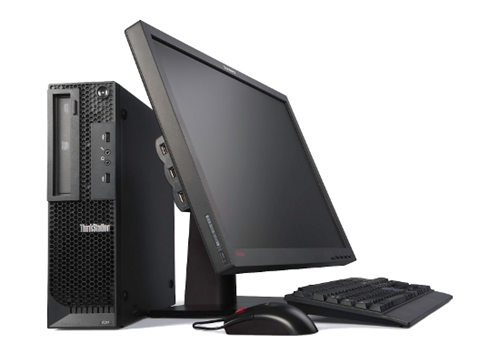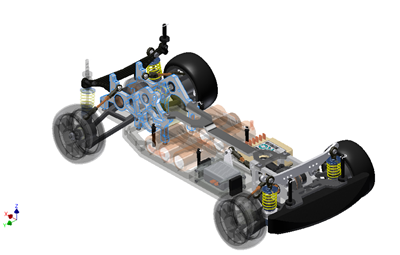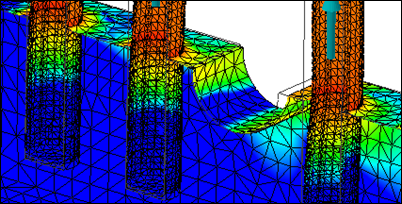After spending some ‘quality time’ with one of Lenovo’s dream machines (the D30), I was left wondering what the company offered the people performing the day to day engineering tasks. They asked if I would take a stab at the Lenovo E31 SFF ThinkStation.
I wanted to see how Lenovo’s entry level to mid-priced machine would performed with my standard routine of modeling and analysis work. The following is a summary of that experience.
Article Outline
- Overview of the Lenovo E31 SFF ThinkStation Workstation
- Specifications:
- Benchmarks
- CAD/CAE Performance
- Wrap Up

Overview of the Lenovo E31 SFF ThinkStation
The Lenovo E31 SFF (Small Form Factor) is part of the Lenovo line of ThinkStation workstation desktop products designed to perform well with CAD / engineering tasks, but still retain a reasonable price point. The unit has a very small footprint and fits into small areas that make it more convenient than many other workstations in a small office environment like mine. (I have this unit installed in the bookshelf adjacent to my desk, which I prefer because it keeps any dust issues to a minimum).
The case is ‘Lenovo robust’, meaning that even though it offers an affordable price tag it is still built very well. All the basic connections are duplicated up front, including the Headphone and Mic, Card readers, DVD drive, and (2) USB ports for easy access. It is styled in the typical Lenovo manner which is quite appealing to me.
The internals are well chosen for typical computer aided design and engineering work. This 4 core Xeon E3-1230 is a good performer; hard drives are fast and easily accessed in a removable plastic tray.

The main drawback is the space limitations. The SFF case offers little space and limits the selection of high end graphics cards. I do not do a great deal of rendering, and as such occasional extended rendering times would be the understandable tradeoff.
Specifications:
Priced at $1274 USD (as tested)
- OS: Windows 7 Professional 64 bit
- Dimensions (WHD): 175mm x 25.2mm x 430.8mm
- CPU: Intel Xeon E3-1230v2 (3.30GHz)
- (up to E3-1280v2 3.6GHz)
- MB Chipset Lenovo with Intel C216 chipset
- RAM: 8GB PC3 1600MHz uDIMM
- (16GB Max)
- Graphics: NVIDIA Quadro 600 1GB Dual link (DVI+DP) LP
- (NVIDIA Quadro 600 max. due to low profile)
- Storage: WD 1TB SATA 7200 rpm 3.5” Drive
- (RAID and 2x240GB SSD available)
- Media Card Reader
- 16x DVD +/- RW DL
- Integrated Ethernet adapter (no wireless available)
Benchmarks
In this review I used the standard software industry benchmarks as well as certain CAD / CAE software to help convey a realistic expectation of the E31’s performance on daily tasks. Additionally I referenced the Lenovo Carbon X1 Touch from a recent review that performed fairly well with standard CAD tasks. It’s not a stellar match, but it represented what I would rate as the minimum performance required for occasional production CAD work.
Lenovo E31 (Carbon X1 reference)
Passmark PT8:
- Mean performance: 2275.2 (1849.2)
- CPU: 9281 (2402)
- 2D Graphics: 754 (509)
- 3D Graphics: 703 (460.6)
- Memory: 2147 (1664)
- Disk: 881 (3811)
Cinebench R11.5
- OpenGL: 24.48 fps (9.8)
- Processor: 6.23 pts (1.62)
SPECviewperf 11
- Catia 03: 17.75
- EnSight-04: 10.64
- Lightwave 01: 51.32
- Maya 03: 38.49
- Pro/E 05: 9.42
- SolidWorks 02: 34.37
- Teamcenter Visualization 02: 15.57
- Siemens NX 01: 13.24
CAD/CAE Performance
Overall I’d say the workstation performed well, in accordance with what we as an industry expect from a lower cost engineering computer. Here’s how the unit performed in different computer aided drafting and engineering CAD/CAE settings.
Inventor Professional 2014
The graphics were sufficiently crisp and the anti-aliasing was acceptable. Highlighting was instant and assembly manipulation was smooth with the RC Car Assembly. I would say that CAD work was definitely a comfortable experience.
In the Static Stress environment, setup and standard manipulation were snappy and the graphics were acceptable. Solve times were unfortunately slower than I would have liked; the hard drive swapping began, which I suspect was a result of only 8GB of RAM. Nevertheless, an SSD would be a requirement of mine in order to speed things along. While switching from one result display to another, the typical delay experienced was about a full second. This is slower than desired when less than 12 components and only ~200000 elements are involved.
The following are an account of comparative timeframes during work activities, using the E31 (and the compared reference machine):
- RC Car model load and update: 49 sec. (33 sec.)
- Start Screen Load time, including local host Vault login: 11 seconds.
- Step File Place / Import: 11 sec. (4.5 Sec)
- Sample linear static stress meshing of 212162 elements: 5.9 sec (11 sec)
- Sample linear static stress solution time: 3 min. 26 sec. (5 min. 41 sec.)
Autodesk Simulation Mechanical 2014
Standard setup workflows were what you would expect; reasonable response, quick highlighting. The Simulation Mechanical Editor Interface is not graphically intense so reasonable performance is expected there.
Once the solver kicked in, the hard drive swapping began and remained quite intense. Adding 8 GB of RAM to max the memory capacity of the E31 SFF may have squelched a good portion of that, but if I were solving a lot of small studies, I would look to the tower version of the E31 in order to get a faster GPU and more RAM.

- Sample brick meshing of 198664 elements, 11 components: 33 sec.
- Sample Static Stress Analysis Solution time: 6.08 min.
Siemens FEMAP v11
While working on linear statics in FEMAP, the E31 was well behaved. View manipulation, connections, and setup went well. Panning and manipulating the graphics window were without issue. Meshing time reasonable, and solve times, while a bit longer than I’d like, were not bad either. The visual quality of the results graphics was much better than I expected.
- Sample meshed 19659 tetrahedral elements, 11 components: 33 sec.
- Sample Static Stress Analysis Solution time: 3 min. 30 sec.
Wrap Up
I think the Lenovo E31 SFF ThinkStation is well placed in organizations that perform CAD work and traditional engineering, both in mechanical and construction services. Its small size also makes it ideal for home offices that need solid performance with a small footprint.
The only significant drawback that limits the unit to CAD and light-weight engineering is the RAM availability. The processor was willing but the lack of ram (as tested) and non-ssd hard drive seemed to drag the system a bit more that I’d like. A maximum of 16GB would be great for most modeling workflows, but marks a significant performance point that CAE, CAM, and visualization professionals have to consider. That said Lenovo also offers the E31 in a tower configuration in order to get some more hardware inside.
The opposite side of that coin is that the Lenovo E31 SFF is priced low enough to allow companies to furnish numerous users with good mid-level performance and save enough in order to purchase a couple multi-CPU Lenovo D30’s to handle the big ticket studies, which I highly suggest.
I would recommend this machine to most CAD professionals needing mid-level performance and those analysts performing FEM setup and small studies. Purchase this machine and insist on 16GB of Ram and at least 1 SSD. Configured like that I believe you will enjoy the performance of the lenovo E31 SFF ThinkStation.






